1. Introduction
 A few weeks ago, we looked at the LG GSA 5169D, an external multi device, which featured all the latest technologies except for LightScribe. Today, we will be reviewing the LG GSA 2166D, a Super multi drive, which supports all the latest formats including Lightscribe, enabling the end user to further customize his burned CD media.
A few weeks ago, we looked at the LG GSA 5169D, an external multi device, which featured all the latest technologies except for LightScribe. Today, we will be reviewing the LG GSA 2166D, a Super multi drive, which supports all the latest formats including Lightscribe, enabling the end user to further customize his burned CD media.
The drive supports the standard 16X burning speed for both the +R and -R DVD formats, 8X and 6X for DVD+RW and DVD-RW respectively, while the +R DL offered maximum writing speed is 8X and 4X for -R DL.
- Features
• With Lightscribe, disk label printing can be completed in under 20 minutes (530 TPI)
• All formats compatible DVD +R/RW, DVD-R/RW, DVD-RAM
• Dual layer recording enables storage of up to 8.5GB (DVD+R/-R DL)
• USB 2.0 Interface
• Portable, both PC and Mac compatible
• 2MB buffer memory with buffer under run prevention technology
- Specifications
| Model |
LG GSA-5169D |
| Colour |
Black |
| Interface type |
USB 2.0 |
| LightScribe Label Printing |
Printing Time |
1070TPI 12cm Entire Disc less than 36 minutes |
| 800TPI 12cm Entire Disc less than 28 minutes |
| 530TPI 12cm Entire Disc less than 20 minutes |
| Weight (kg) |
1285.9g |
| OS-Compatability |
Windows 2000 Professional, XP Home & Prof, ME(Not support LightScribe) |
| Access time |
|
| DVD-RAM |
250 ms |
| DVD-ROM |
140/175 ms |
| CD |
120 ms |
| Buffer Memory |
2MB with buffer under run prevention technology |
| Data transfer rate |
|
| CD |
Max 7,200KB/s |
| DVD |
Max 22.16 Mbytes/s |
| Dimensions W x D x H (mm) |
160 x 230 x 50 |
| Disc Loading Method |
Motorized Tray |
| Writing Method |
|
| DVD-RAM |
Random Write |
| DVD+R |
Sequential Recording,Sequential Recording,Random Write |
| CD-R / RW |
Disk-at-Once, Track-at-Once, Session-at-Once, Packet Write |
| DVD-R |
Sequential Recording |
| DVD-R /RW |
Disk-at-Once,Incremental Recording Overwrite |
| DVD-RW |
Sequential Recording |
| Write Speed |
|
| DVD+R |
2.4x, 4x CLV, 8x ZCLV, 12x PCAV, 16x CAV |
| DVD-R |
2x, 4x CLV, 8x ZCLV, 12x PCAV, 16x CAV |
| DVD+RW |
2.4x, 4x CLV, 8x ZCLV |
| DVD-RW |
1x, 2x, 4x CLV, 6x ZCLV |
| DVD-RAM |
2x, 3x, 5x CLV(Ver.2.2) |
| CD-R |
16x CLV, 24x ZCLV 32x, 40x,48x CAV |
| CD-RW |
4x, 10x, 16x CLV, 24x, 32x ZCLV |
| DVD+R DL |
2.4x, 4x CLV, 6x, 8x ZCLV |
| DVD-R DL |
4x CLV |
| Read Speed |
|
| CD-ROM |
Max 48x |
| DVD-ROM |
Max 16x |
Below are the drive's main specs as given by NeroInfoTool, DVDInfoPro and VSO inspector:

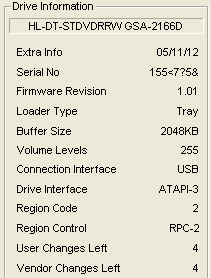

- Retail package

The retail package contains everything that is necessary to set up the drive and use all of its features, including all required software. The package contains:
- The External Super Multi drive GSA-2166D
- LG DVD Writer Solution CD containing
- Nero Express
- Nero BackitUp
- Nero Cover Designer
- InCD
- Cyberlink Power Producer Gold
- Power DVD
- Owner's manual.
- a USB 2.0 Cable
- a Power Adapter/Cord for the power supply
-The Drive
Simple in design, the LG GSA-2166D comes in one color only, black, as we can see in the pictures below. The front bezel carries the following logos:
- SuperMulti
- RW DL
- LightScribe
- DVD Multi Recorder
- and of course, LG
On the bottom right are activity LED indicator and the eject button.

On the rear panel, the drive has the USB port and the DC Power Supply connection. As we said, a simple design.

- Installation

The drive was installed under WindowsXP and was
recognized as "HL-DT-ST DVDRRW GSA-2166D ". The drive came with the latest available firmware installed (firmware revision 1.01), and as no further firmware releases had been made, we moved straight to the tests.
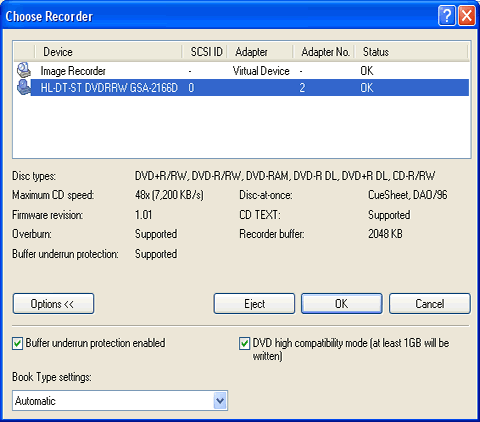
For comparison, we will be posting the results of the 2166D along with the results of the Samsung SE-W164C and LiteOn 1653S external drives.
2. Reading Tests
- CD Format
 The LG 2166D supports up to 48X reading speed for CD media and up to 32X for RW media. We used both these media types to verify the drive's reading speed with the CD-DVD Speed utility.
The LG 2166D supports up to 48X reading speed for CD media and up to 32X for RW media. We used both these media types to verify the drive's reading speed with the CD-DVD Speed utility.


After several retries, in order to confirm the results reported by CDspeed and a Pressed Plextools CD-ROM, the maximum supported reading speed was only 42X instead of the 48X stated in the manufacturer's specifications. The 32X maximum reading speed for CD-RW media however, was confirmed.
- AudioCD
For these tests, we used a pressed AudioCD and the Advanced DAE CDSpeed feature.
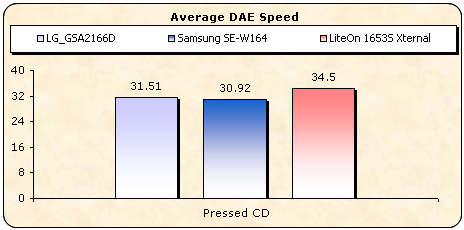

According to the Average DAE Speed test, the average reading DAE speed for the 2266D was 31.5X, whereas Nero CD Speed Advanced DAE Quality test awarded a perfect 100 quality score with an average speed of 28.65X. The drive can read leadin and subchannel Data and CD Text.
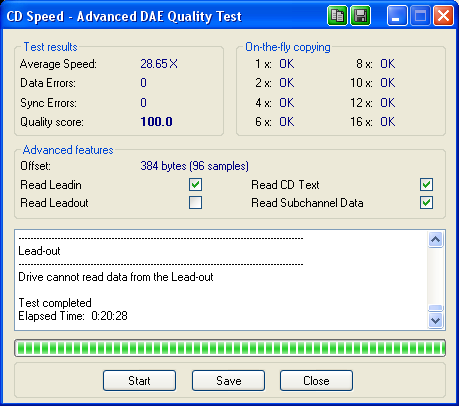
- 90mins Audio disc

- 99mins Audio disc
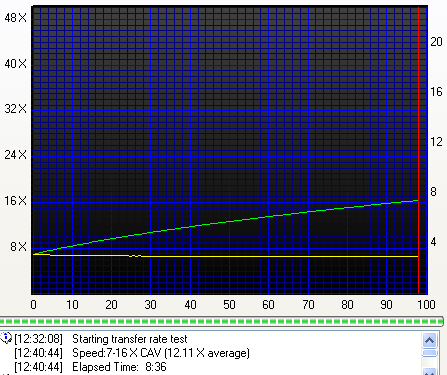
Unfortunately, the drive could not read the 90min Audio disc, but managed to successfully read all the way to the end the 99min Audio disc.
- DVD Format
 We repeated the reading tests, this time using a collection of pressed SL and DL DVD media to test the drive's reading capabilities with DVD media.
We repeated the reading tests, this time using a collection of pressed SL and DL DVD media to test the drive's reading capabilities with DVD media.

All three drives support up to 16X reading speed with Pressed SL media. The reviewed drive along with the Samsung, produced a distinct 16X maximum reading speed while the LiteOn reported a max speed of just 14X.

The two layers of a PTP DVD-ROM disc are read sequentially with the drive starting reading from the inner part of the disc, which is the beginning of each layer, progressing towards the outer range, for each layer. 8X maximum supported speed for this DL Pressed DATA disc.

The graph shown above indicates the reading performance of the drive with OTP dual layer media. The first layer of an OTP dual layer DVD-ROM is read exactly the same way as the first layer of the PTP disc we tested previously. The difference here is the reading strategy of the second layer of the disc. The beginning of the second layer is located in the outer part of the disc, so the drive starts reading from the outer tracks towards the inner part of the disc. More or less same performance from all three drives, as all three devices support the same reading speed with this kind of media.


Both -R and +R Write Once media were read by the 2266D at a maximum speed of 16X, while the Samsung and LiteOn drives support 12X and 8X maximum reading speeds respectively.

The reported ripping speed was 8757Kb/s, which is approximately 6.6X DVD speed.
- DVD-RAM
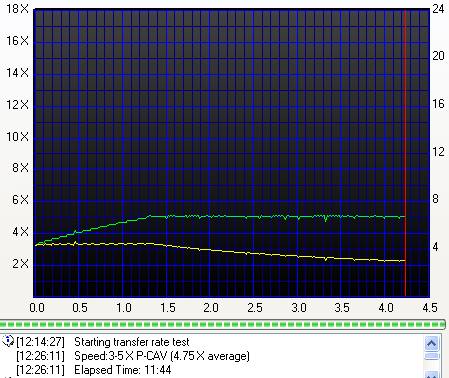
The maximum supported speed with DVD-RAM media is 5X. No changes in speed with the RAM format yet, but we will soon witness changes, with speeds going all the way up to 12X from all the well known manufacturers.
Overall, the GSA 2266D is a good reading device, with good speeds for both CD and DVD. Even though the drive could not reach 48X for CD-ROM media, as per the manufacturer's specifications for this media, it managed to read at 16X, both DVD+R and DVD-R write once media, which is quite impressive when compared to the other two external drives.
- Appendix
Nero CD-DVD Speed Graphs
3. CD Error Correction
In the following tests, we check the drive's behavior when it comes to reading
scratched / defective discs. The test discs we use are the ABEX series
from ALMEDIO.
- ABEX TCD-721R

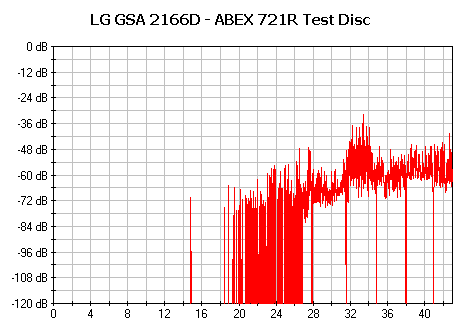
|
Errors total
|
Num: 854948
|
|
Errors (Loudness) dB(A)
|
Num: 51160
|
Avg: -74.7 dB(A)
|
Max: -31.6 dB(A)
|
|
Error Muting Samples
|
Num: 2782
|
Avg: 1.1 Samples
|
Max: 89 Samples
|
|
Skips Samples
|
Num: 0
|
Avg: 0.0 Samples
|
Max: 0 Samples
|
| Total Test Result |
76.8 points (of 100.0 maximum) |
Quite good performance. A low total error count and low maximum error loudness level, as well as no skipped samples indicate good performance which is confirmed in the result score of 76.8.
- ABEX TCD-726


|
Errors total
|
Num: 23 |
|
Errors (Loudness) dB(A)
|
Num: 90
|
Avg: -89.0 dB(A)
|
Max: -76.1 dB(A)
|
|
Error Muting Samples
|
Num: 0
|
Avg: 0 Samples
|
Max: 0 Samples
|
|
Skips Samples
|
Num: 0
|
Avg: 0 Samples
|
Max: 0 Samples
|
|
Total Test Result
|
91.0 points (of 100.0 maximum)
|
Unfortunately, the drive could not achieve flawless reading with the 726 test media. A little unexpected considering its performance with the TCD-721R disc previously. Nevertheless, 91.0 points is still good.
- CD-Check Audio Test Disc
 The CD-Check Test Disc is a very useful tool for evaluating the Sound Reproduction
/ Error correction capabilities of a CD player. The disc offers a signal combination
with disc error patterns to rate the drive's ability to read music and reproduce
it completely. Five tracks on the disc contain a sequence of progressively
difficult tests. These tracks are referred as Check Level -1 through Check
Level -5.
The CD-Check Test Disc is a very useful tool for evaluating the Sound Reproduction
/ Error correction capabilities of a CD player. The disc offers a signal combination
with disc error patterns to rate the drive's ability to read music and reproduce
it completely. Five tracks on the disc contain a sequence of progressively
difficult tests. These tracks are referred as Check Level -1 through Check
Level -5.
The
tracks are reproduced (played) through a software multimedia player
(i.e. Windows Media Player). Each level is considered as passed, if the tone
coming
out
from the speakers is smooth, continuous without interruptions, skipping or
looping. The higher the Check Level passed, the more reliable the sound reproduction
of the tested device.
|
Error Level
|
1
|
2
|
3
|
4
|
5
|
|
LG GSA-2166D
|
5/5
|
5/5
|
5/5
|
0/5
|
0/5
|
Average performance with this disc, where the drive managed to read the third track without error. In the fourth and fifth tracks, the drive produced audible clicks and so could not fully correct the errors present.
Overall, average to good CD Error Correction mechanism.
4. DVD Error Correction
In the following tests, we examine the DVD reading capabilities of
the LG GSA-2266D drive with scratched / defective
DVD media.
For the tests, we used CDVD Benchmark and Nero CDSpeed. The reference test
media
comes
from
ALMEDIO.
- Single Layer media
ABEX TDR-821
This is a single sided, single layer DVD-ROM with 4.7GB capacity, and its
surface has an artificial scratch of dimensions varying from 0.4 to 3.0 mm.
The following transfer rate picture comes from the CDVD Benchmark v1.21 transfer
rate test.


Without errors or drops in speed and at a maximum reading speed of 8, the drive managed to read this SL test media all the way to the end.
ABEX TDR-825
This is also a single sided, single layer DVD-ROM of 4.7GB capacity. The
data structure of the disc is exactly the same as that of the TDR-821, with
the difference that there are no scratches on it but instead, defective areas
of dimensions ranging from 0.5 to 1.1 mm. There are also fingerprints sized
between
65 and
75 micrometers.


Here too, this time with SL media, the drive again managed to read through to the end without error or any significant drops in speed (yellow dots).
- Dual Layer media
ABEX TDR-841
This is an 8.5GB dual layer, single sided DVD-ROM disc with artificial scratches
of dimensions ranging from 0.4 to 3.0mm, on both layers.

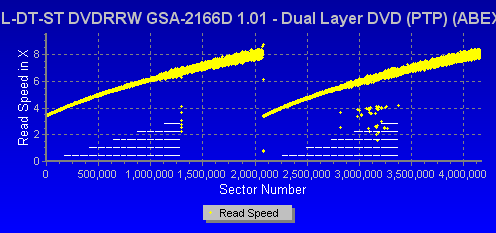
In this test, the drive read through both layers at a maximum reading speed of 8X. There were no errors or significant drops in speed.
ABEX TDR-845
This test disc is a single sided, dual layer DVD-ROM disc with a capacity
of 8.5GB. The only difference between the TDR-845 and the TDR-841 discs is
that the first includes
defective areas and fingerprints. The dimensions of the defective areas ranges
from 0.5 to 1.1 mm and the fingerprints are sized from 65 to 75 micrometers.


Very good performance.
ABEX TDV-541
The TDV-541 is a single sided, dual layer DVD-VIDEO disc, with a capacity
of 8.5GB. The disc is based on the TDV-540 series which is designed for inspection
and adjustment of DVD-VIDEO players. The disc checks the layer switch operation
from layer 0 to layer 1 and also includes test pictures and test signals for
DVD sound files. The current TDV-541 also checks the error correcting
capabilities of the drive and includes scratches from 0.4 to 3.0 mm.


Even though CDSpeed reported some fluctuations in speed during the second layer, the drive managed to successfully complete the reading process in 19:06mins.
ABEX TDV-545
The
TDV-545 disc is based on the TDV-540 series. It is a single sided, dual layer
DVD-VIDEO disc with a capacity of 8.5GB. The TDV-545 includes artificial black
dots on the data surface, sized from 0.4 to 1.0 mm. It also has 65 - 75
micrometer fingerprints.

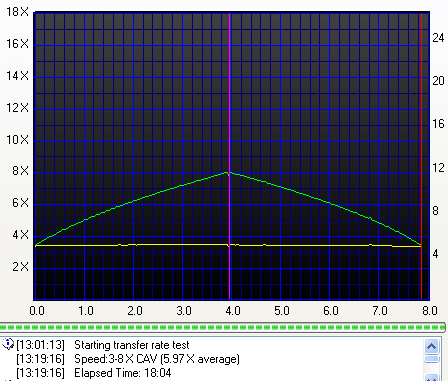
Smooth reading, no speed fluctuations whatsoever. Good performance.
In all cases, the maximum reading speed was 8X. The drive did not drop speed while reading over the defective areas with any of our test discs except for the 541 test disc, but it still managed to complete the test without errors. Overall, very good error correction capabilities. The only comment would be perhaps a faster reading speed.
5. Protected Discs
At this point, we will check the drive's ability to read and backup protected CDs.
- AudioCD protections
 For the test procedure we used three audio discs with different audio copy protections. The ripping process on all protected audio discs was carried out with Exact Audio Copy v0.9 beta5.
For the test procedure we used three audio discs with different audio copy protections. The ripping process on all protected audio discs was carried out with Exact Audio Copy v0.9 beta5.
The protected audio discs tested, were:
| Audio Discs |
Protection |
| Celine Dion - New Day Has Come |
Sony's Key2Audio |
| Natalie Imbruglia - White Lilies Island |
Cactus Data Shield 200 |
| Aiko Katsukino - The Love Letter |
Cactus Data Shield 200.0.4 - 3.0 build 16a |
The Cactus Data Shield 200, contains artificial errors that are not easily bypassed by the reader, while the Key2Audio contains a second session causing problems to readers when trying to read the Table Of Contents (TOC).
The tested tasks are:
- Recognition of the inserted disc (Yes/No).
- Ripping all wav files (with EAC's Burst Mode) to the hard disk through copy&compare function.
- Listening to the produced wav files to detect any possible click/skips.
The drive recognized up to the 12th Audio track in the CDS200 disc,
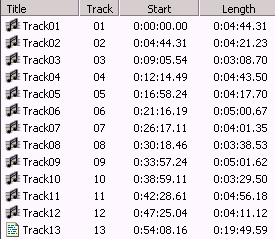
and with the "Retrieve Native TOC" option removed, the drive recognized the 13th track.

The test results are shown in the following table:
| LG GSA 2166D |
Key2Audio |
CDS200 |
| Unfortunately, the drive could not overcome the specific protection scheme. |
Ripping process completed, EAC reports no problems, Read&Test CRC comparison successful for all tracks |
Only the CDS200 protected disc was read successfully.
- Cactus Data Shield 200.0.4 - 3.0 build 16a (Aiko Katsukino - The Love Letter)
This is a "special" CDS200 build, since it doesn't contain any artificial errors which create problems during the ripping process. Most problems occur when trying to write the ripped wav files, since the produced CD-R disc contains C2 and CU errors! This "problem" is rumored to be connected to specific chipset weaknesses.
| LG GSA 2166D |
CDS 200.0.4 - 3.0 build 16a |
| Reading performed without any errors. |
- Games Protections
 To create the image of the various protected titles in the hard disk, we used Alcohol 120% software and the appropriate settings, in accordance with the protection type of the inserted discs. Below you can see the duration of each process as well as the transfer rate in each case.
To create the image of the various protected titles in the hard disk, we used Alcohol 120% software and the appropriate settings, in accordance with the protection type of the inserted discs. Below you can see the duration of each process as well as the transfer rate in each case.


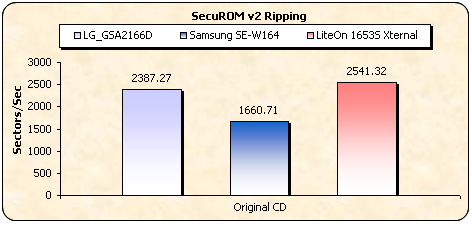

The LG drive managed to achieve relatively fast times with all three protection schemes.
- Writing Tests
The GSA 2166D supports the DAO-RAW writing mode. To check the drive's
EFM correction status we used 5 different game titles with different SafeDisc
2 versions, having the latest software patches installed. After making the images
of the various titles onto the hard disk, we burned them (at maximum speed) with
Alcohol 120% v1.9.2.3105. Two different discs were recorded for each title;
one with the "Rectify Sub-Channel Data" enabled and one with the function
disabled.
- Quake 4 SafeDisc v4.6
- Fifa 2004 - SafeDisc v3.1x
The drive failed to create working backups of the above protected games.
6. CD Recording Tests
The GSA 52166D supports up to 48X writing speed with CD media, while it supports up to 32X with CD-RW.

According to Nero CDSpeed, the drive confirmed its maximum 48X writing speed. The
test started at 21.53X and finished at 48.53X, having an average speed of 36.77X.
Click on the image below for a larger view.
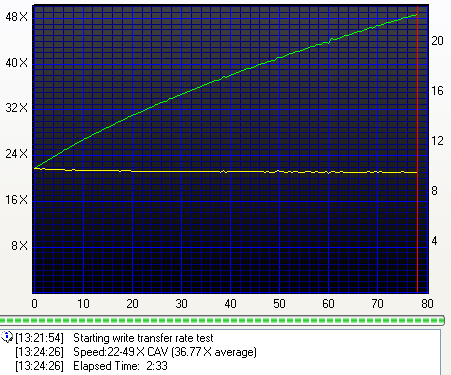
For the burning tests, we created an 80min data compilation through Nero
Burning Rom, recording the data on several 700MB discs. The drive
needed only 2:28 minutes to complete this task at the
maximum 48X writing speed.
In the following graph we can see the recording times of the 2166D with various CD-R media.

The GSA-2166D supports 32X Z-CLV rewriting speed with Ultra Speed Rewritable Media
(US-RW).
Below you can see the Nero CD-DVD Speed writing simulation test with blank
24X US-RW media from Mitsubishi Chemicals.
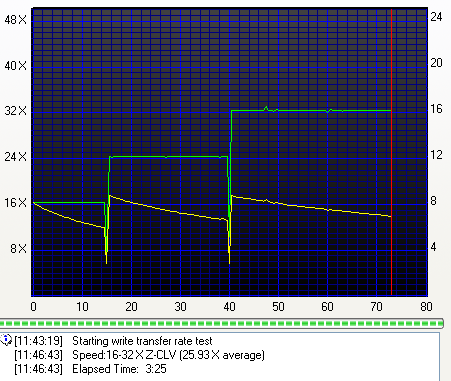
The drive starts the writing task at 16.10X and reaches a maximum of 32.18X having an average speed of 25.93X
- Overburning Test

The drive supports CD Overburning.
7. CD Writing Quality - Plextools
 We measured the C1 / C2 error rate on the recorded discs we burned at the
maximum supported writing speed of 48X. The software we used is PleXTools Professional
v2.28, and more specifically the built-in Q-Check utility. The
reader was the Plextor PX-716A (firmware v1.09).
We measured the C1 / C2 error rate on the recorded discs we burned at the
maximum supported writing speed of 48X. The software we used is PleXTools Professional
v2.28, and more specifically the built-in Q-Check utility. The
reader was the Plextor PX-716A (firmware v1.09).
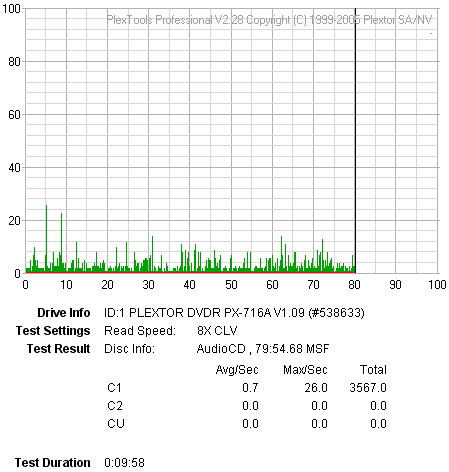


- Summary
According to the above results from the Plextools Professional Quality Check utility, the BenQ and Philips media produced good quality, with zero C2 errors while TY media produced CU errors. In this test, any CU errors reported with any media indicate uncorrectable errors and constitutes a failed burn.
8. CD Writing Quality - Clover System
The Clover Systems CDX Compact Disc Analyzer is a high-speed tool to quantitatively measure the quality of a CD. It will analyze CD-DA, CD-ROM, CD-ROM XA, CD-I, CD-R, Photo-CD, Enhanced CD and CD-RW discs at 4X, 8X, 24X, 32X or 40X speed. It effectively measures disc quality by examining the quantity and severity of CIRC errors generated during playback. It also provides the capability to measure signal parameters related to pit geometry, such as asymmetry and reflectivity. Together, all these bits of information provide a thorough analysis of disc quality. The Clover Systems Analyzers can also perform various format-checking tests on data discs, and do bit-for-bit data comparison on all types of CDs. All tests are carried out at the maximum speed of 40X.
CIRC error correction uses two principles to detect and correct errors. The first is redundancy (extra information is added, which gives an extra chance to read the disc), and the second is interleaving (data is distributed over a relatively large physical area). The CIRC error correction used in CD players uses two stages of error correction, the well known C1 and C2, with de-interleaving of the data between the stages.
The error type E11 means one bad symbol was corrected in the C1 stage. E21means two bad symbols were corrected in the C1 stage. E31 means that there were three or more bad symbols at the C1 stage. This block is uncorrectable at the C1 stage, and is passed to the C2 stage. Respectively, E12 means one bad symbol was corrected in the C2 stage and E22 means two bad symbols were corrected in the C2 stage. E32 means that there were three or more bad symbols in one block at the C2 stage, and therefore this error is not correctable.
BLER (Block Error Rate) is defined as the number of data blocks per second that contain detectable errors, at the input of the C1 decoder. Since this is the most general measurement of the quality of a disc, you will find BLER graphs for all media tested below. If you click on the images you can see a more detailed table, indicating error levels. The Red Book specification (IEC 908) calls for a maximum BLER of 220 per second averaged over ten seconds. Discs with higher BLER are likely to produce uncorrectable errors. Al low BLER shows that the system as a whole is performing well, and the pit geometry is good. However, BLER only tells us how many errors were generated per second, and it does not tell us anything about the severity of those errors.

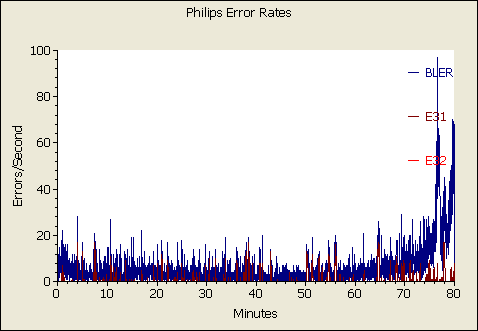

- Summary

In this previous page, we checked three burned CD media with the Plextools Q-check utility. Now, we tested the same three media, with a more sophisticated and accurate utility, the Clover CDX Test. Unfortunately, it did not concur with the Plextools utility. As we can see from the above table, which presents the results in detail, all three media were found to be of bad quality, even BenQ which according to Plextools, was of very good quality with very low C1 count and levels. Philips media showed the best quality with a C grading.